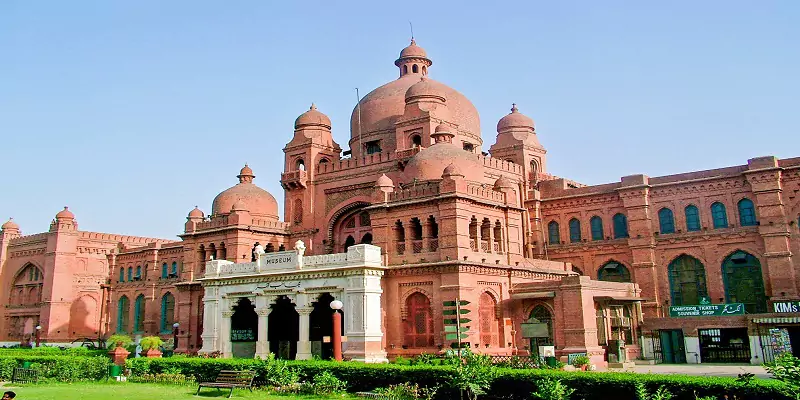Lahore Museum
The Lahore Museum, located in the heart of Lahore, Pakistan, stands as a testament to the rich cultural heritage, historical legacy, and artistic achievements of the Indian subcontinent. Established in 1865 during the British colonial era, the museum has evolved into one of the most significant repositories of artifacts, artworks, and historical treasures in South Asia. Its extensive collection spans various periods, from ancient civilizations to the colonial era, offering visitors a comprehensive journey through the region's diverse history.
The Lahore Museum's establishment can be traced back to the efforts of Sir Henry Lawrence, the then Chief Commissioner of the Punjab province, who envisioned a space to preserve and showcase the cultural wealth of the region. The initial collections were housed in the Tollinton Market, and the museum formally opened its doors to the public in 1894 at its current location in the Lahore Mall.
The Lahore Museum's architectural design is a blend of Victorian and Sikh architectural styles, reflecting the historical transitions and influences that the region has undergone. The red-brick façade, arched doorways, and a central dome add to the museum's visual appeal. The elegant structure, set amidst lush gardens, creates an inviting ambiance that complements the treasures it holds within.
Collections and Galleries:
The Lahore Museum boasts an extensive and diverse collection, making it a treasure trove for historians, scholars, and art enthusiasts. The artifacts are categorized into various galleries, each dedicated to specific themes, eras, or civilizations.
- Gandhara Art Gallery:
The Gandhara Art Gallery is a highlight of the Lahore Museum, showcasing artifacts from the ancient Gandhara civilization, which flourished in the region between the 1st century BCE and the 5th century CE. The collection includes intricately carved sculptures, Buddha statues, and artifacts that provide insights into the artistic and religious expressions of the time.
- Islamic Art Gallery:
This gallery features a stunning collection of Islamic art, including calligraphy, ceramics, manuscripts, and metalwork. The items on display span various Islamic dynasties, offering a comprehensive overview of the artistic achievements within the Islamic world.
- Fasting Buddha Gallery:
Home to the renowned Fasting Buddha, this gallery focuses on artifacts from the ancient Buddhist period in the subcontinent. The centerpiece, the Fasting Buddha, is a magnificent sculpture depicting Buddha during his period of fasting and meditation.
- Sikh Gallery:
The Sikh Gallery pays homage to the Sikh period in the region's history, displaying artifacts related to the Sikh Empire and its cultural contributions. The gallery features paintings, weapons, and personal belongings of Sikh rulers.
- Mughal Gallery:
As a repository of Mughal artifacts, this gallery offers a glimpse into the opulent era of the Mughal Empire. Manuscripts, paintings, jewelry, and textiles showcase the grandeur and artistic finesse of the Mughal period.
- Pre-Harappan and Harappan Gallery:
Focusing on the ancient civilizations of the subcontinent, this gallery displays artifacts from the pre-Harappan and Harappan periods. Pottery, seals, and tools provide insights into the early stages of human civilization in the region.
- Ethnological Gallery:
This gallery explores the diverse cultures and traditions of the people of Pakistan. Traditional costumes, jewelry, musical instruments, and everyday objects are displayed to illustrate the rich cultural tapestry of the region.
- Coin Gallery:
Numismatists and history enthusiasts find the Coin Gallery intriguing, as it houses an extensive collection of coins from different periods and civilizations. The coins not only serve as monetary artifacts but also offer insights into the economic and political history of the region.
- Manuscripts and Miniature Paintings Gallery:
This gallery is a visual treat for lovers of literature and art. It showcases intricately illuminated manuscripts and miniature paintings from different periods, highlighting the artistic achievements of the subcontinent.
- Stone Sculpture Gallery:
The Stone Sculpture Gallery features a remarkable collection of stone sculptures from various periods, displaying the evolution of artistic styles and techniques.
The Lahore Museum plays a crucial role in preserving and protecting the cultural heritage of Pakistan. Its conservation efforts extend beyond the galleries to include a conservation laboratory where experts work tirelessly to restore and maintain artifacts. The museum's commitment to preservation ensures that future generations can continue to appreciate the richness of the region's history and culture.
In addition to its role as a repository of artifacts, the Lahore Museum actively engages in educational initiatives. It conducts workshops, lectures, and educational programs to promote awareness and understanding of the cultural and historical significance of the collections. The museum serves as an educational hub, welcoming students, scholars, and researchers to delve into the wealth of knowledge it holds.
While the Lahore Museum stands as a cultural beacon, it faces challenges such as limited resources, space constraints, and the need for modernization. Efforts are underway to address these challenges, with plans for expansion, digitization of collections, and improved facilities to enhance the visitor experience.
Visitor Experience:
A visit to the Lahore Museum is a journey through time, offering a panoramic view of the subcontinent's cultural evolution. The well-curated galleries, informative displays, and the sheer diversity of artifacts make it a must-visit destination for anyone interested in the history and heritage of South Asia.
The Lahore Museum stands as a guardian of thesubcontinent's cultural and historical legacy. Its architectural grandeur, diverse collections, and educational initiatives make it a vital institution in Pakistan's cultural landscape. As it continues to evolve and adapt to contemporary challenges, the Lahore Museum remains a beacon of knowledge, inviting visitors to explore the rich tapestry of the region's past.

